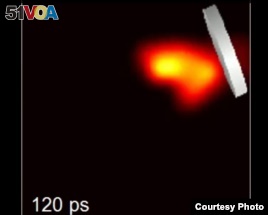15 February, 2015
From VOA Learning English, this is the Technology Report.
Imagine a camera that can take one hundred billion pictures a second -- that is enough to record the fastest movements in the universe.
But we do not have to imagine it, because a scientist has invented such a camera. He calls it an imaging system. It may seem like science fiction, but it is science reality.
Lihong Wang is a biomedical engineer at Washington University in St. Louis, Missouri. He leads a team of researchers who have discovered several new imaging techniques.
"For the first time, humans can literally see light pulses traveling in space at the speed of light."
The speed of light is almost 300 million meters per second. At that speed, it would take just one second to travel around the world seven-and-a-half times. Mr. Wang photographs light particles moving at that speed using a unique camera.

A screen grab from YouTube captured by Wang's new imaging system shows a laser pulse propagating in air and being reflected from a mirror. (Credit Lihong Wang, Washington University)
"The streak camera is a very specialized device that allows us to convert time into space. We convert light particles, or photons, into electrons, then pull the electrons, really hard, at different rates, depending on the time of arrival. So the time of arrival will be converted into different vertical positions."
Mr. Wang's new technology improves on other ultra-fast cameras in important ways. Until now, streak cameras could only take a one-dimensional photograph. That is like looking through a vertical opening and trying to take a picture of something flying by really fast.
The fastest cameras had to have an external, or outside, light source to work. But Mr. Wang's technique does not need special lighting. It produces two-dimensional images like regular photographs, but at a speed of one image every 10 trillionths of a second.
Brian Pogue is a biomedical engineer at Dartmouth College in the eastern American state of New Hampshire. He reviewed the new imaging system for the science publication Nature. He says this new way of seeing the movement of light could lead to major scientific discoveries in areas like optical cloaking.
"Cloaking" is a kind of technology that can make an object -- like a spaceship -- seem to disappear. Mr. Pogue says the military would like to use cloaking.
"There's a lot of interest in getting light to bend around objects, so it sort of looks like you're seeing through them."
Brian Pogue says Mr. Wang's new system lets researchers photograph light as it bends. He says they have not been able to do that until now. He says this development could help make optical cloaking a reality.
Lihong Wang imagines other uses for the new camera in such scientific fields as molecular biology and astronomy. He says ultrafast imaging could lead to new discoveries.
And that's the VOA Learning English Technology Report. For more technology stories, go to our website 51voa.com. I'm Jonathan Evans.
______________________________________________________________
Words in this Story
astronomy – n. the scientific study of stars, planets, and other objects in outer space
optical – adj. relating to or using light
cloak – v. to hide or disguise something
molecule – n. the smallest possible amount of a particular substance that has all the characteristics of that substance
technique – n. a way of doing something by using special knowledge or skill